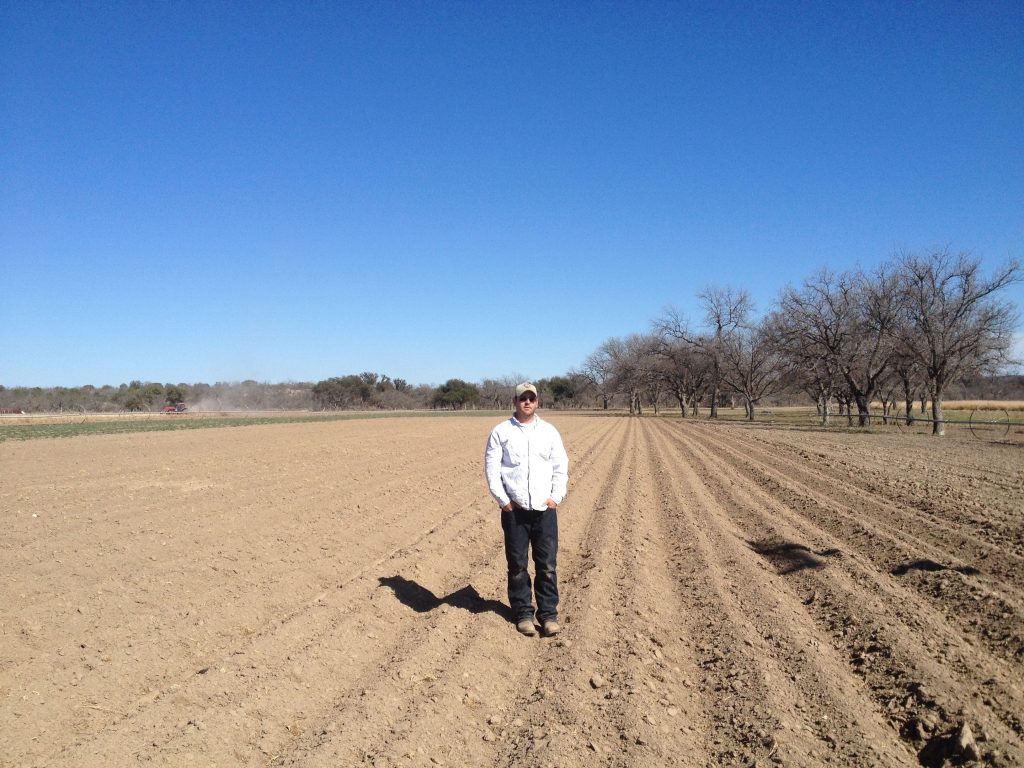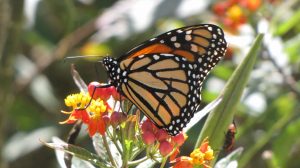Native American Seed Company is on a mission to restore the earth, one native seed at a time.
The 300-acre spread about 115 miles west of San Antonio on the banks of the Llano River just northeast of Junction, Texas, boasts 75 acres of native plants in production

Antelope horns milkweed pods last June at Native American Seed in Junction, Texas. Photo courtesy Native American Seed
for the distinct purpose of harvesting native seed.
The company’s nondescript cedar post gate opens onto a caliche drive that winds through classic Hill Country mesquite, agarita and sotol, then spills into planted rows of huisache daisy, standing cypress, gayfeather, American blanketflower and other native wildflowers and grasses. Water pumped from the nearby Llano River maintains the verdant fields, and allows the company to grow, harvest, process, package and ship more than 170 species of native seed and 30 seed mixes nationwide.

Antelope Horns milkweed last June, after well-timed and regular rains in early 2012. Photo courtesy Native American Seed
Among the seed stock, two native Texas milkweeds, Asclepias asperula, commonly known as Antelope horns, and Asclepias viridis, often called Green milkweed, have challenged the 25-year-old seed company’s experts. The Monarch butterfly host plants are essential to the Monarch butterfly migration, which funnels south through the Texas Hill Country each fall. Native milkweeds are famously difficult to propagate, even for professionals. “Species in Texas may not lend themselves to mass seed production,” said George Cates, chief “seed wrangler” at Native American Seed.
Native Texas milkweeds require stratification–cold and moisture to soften up their outer shells. They need 45 days of moist conditions, specific soil conditions, and alternate wet and dry periods. Worst thing you can do: overwater them. (Check out Native American Seed’s Milkweed Stratification process at this post.)
Gardeners and butterfly fans committed in theory to propagating and planting native milkweeds (and I consider myself among them) have been vexed in practice by their persnickety ways. That’s what often drives us to plant Tropical Milkweed, the nonnative Asclepias curassavica that is easy-to-grow, widely available and the favorite of Monarch butterflies for hosting and other butterflies for nectar. While the practice bothers some scientists and native plant purists, our rationale is that Monarch caterpillars need to eat. In short, it’s better to provide SOME host plant for migrating Monarchs than NONE as they pass through Texas.

George Cates stands in a field of future Antelope Horns in April. Nothing sprouting yet. PHoto by Monika Maeckle
Native American Seed and the Portland-based Xerces Society, a nonprofit organization devoted to protecting invertebrates and their habitats, hope to change all that.
In 2010, the Xerces Society approached the 18-person staff of the Native American Seed Company about establishing a partnership to restore native milkweeds to the American landscape. Xerces had recieved a $117,000 conservation innovation grant from the USDA’s National Resources Conservation Service. “We call it the ‘milkweed CIG,'” said Brianna Borders, project manager for the undertaking, since renamed Project Milkweed. A requirement of the grant was that the recipients match the sum by raising an equal amount.
Project Milkweed identified several U.S. regions for milkweed seed production–California, the Great Basin, Arizona, New Mexico, Florida, and Texas. “Texas was a clear choice, arguably the most important state to the Monarch migration,” said Borders. The $334,000 was pretty much divied up equally between the areas, she said.

Native American Seed was an ideal candidate for the project, said Borders, because of the company’s long involvement in native seed production and its opportune location on the Monarch flyway. Founder Bill Nieman, a high school dropout who turned a trash hauling business into a successful landscaping and design firm and then into Native American Seed, has a long history as a conservationist. The company’s mission aligned perfectly with the task.
The company’s 100-page catalogue practically serves as a free native plant guide. The vivid and abundant photography, renderings of how seeds look when they sprout, and descriptive verbiage describing each plant’s soil type, sunlight needs, and other traits

Native American Seed will use its full irrigation alltoment from the Llano River to produce native seeds. Photo by Monika Maeckle
offer a broad overview of the life cycle of many plants native to the U.S. Especially entertaining is Nieman’s annual introductory letter in which he tackles topical environmental issues–from invasive plants and water waste to wind power lines.
Results for the Mlikweed Project have been mixed so far. The program launched just as Texas entered the ongoing historic drought. In April 2011, the milkweeds didn’t flower or produce seed (which is expected, given they are perennials). Borders said the first seed harvest last year (2012) was “pretty modest.”The 2,400 linear feet of native milkweeds produced 1.5 pounds of seed, which, at an average of 65,000 seeds per pound, amounts to almost 100,000 seeds. Of those 100,000 seeds, 95% have been restratified and replanted.
“We didn’t set a target for how much seed has been produced because there are so many unknowns,” said Borders.
Meanwhile, others have tackled the daunting task of producing milkweed plugs. Monarch Watch, based at the University of Kansas at Lawrence, launched a “Bring Back the Monarchs” milkweed restoration campaign back in 2010. Last fall, the program got a second life here in Texas when it partnered with the Native Plant Society to recruit volunteers to gather native seed, then mail them to Kansas for cultivation there.

The milkweed restoration campaign previously used a Texas grower. Pat McNeal, of McNeal Growers in Manchaca, Texas, assumed those duties in 2012, but said recently that Monarch Watch “had better success in Kansas where they have four real seasons.”
McNeal suggested that the best way to propagate Texas native milkweeds would be to cultivate the tubers for two years, then plant those in the fall. “These milkweeds don’t adapt their schedules for us,” he said, adding that Texas native milkweeds don’t do well in containers. The plants can have a two-meter long tap root making them difficult to transplant. “It’s like trying to grow a potato in a pot,” said McNeal.
Dr. Chip Taylor, who oversees the program, continued cultivation this year with a Kansas grower. He said he anticipates that 25,000 native milkweed plugs will have been produced this spring. All have been sold on preorder. Monarch Watch will soon set up a “Milkweed Market” for retailers on its website so people can connect with growers in their area.

Cates points out root stock from 2012’s Antelope Horns milkweed crop, which has yet to sprout this year because of a lack of rain. Photo by Monika Maeckle
At Native American Seed, the battle for Texas native milkweed seed plods on. Cates assumes primary responsibility for their production. He joined the company in 2003 as a student intern in ecological sciences at Austin College in Sherman, Texas. After graduating he came on fulltime in 2007.
On a windy Friday afternoon in April, Cates pointed to the dry landscape. “The grass hasn’t been green since 2010,” he said. With the Llano River flowing at an historic low, Cates mentioned the seed company will once again use its entire irrigation allotment, strategically watering wildflowers and native grasses, supplementing with a recently installed rainwater collection system.
A dry winter coupled with early, hot tempertures, watering restrictions on the Llano, and an unpredictable climate suggest months of hard work and frustration ahead for Cates. But the difficulties haven’t dampened his zeal for restoring native plants with seeds. “A plant in the ground will produce 100x more seed than tubers,” he said. “That’s where we’re at–we’re trying to grow a substantial amount of this seed material.”
Cates has little patience for Tropical milkweed, the easy answer for gardeners in the long haul of native plant restoration. “We’re all about having it right now,” said Cates. “These kinds of conservation efforts can’t be done ‘right now.’ It takes time.”
“Every time you vote for Tropical milkweed with your dollar, you vote against this,” he said, pointing to tidy, dry rows of future Antelope horns, which had yet to sprout this year.
Cates kneeled down and dug his fingers into the soil to find root stock from the 2012 milkweed crop. “Half of what we do fails, but that doesn’t make us stop.”


I’m a wholesale native wildflower seed producer and board member of the MO Native Seed Association. I’m located in central MO and interact with NRCS Elsberry PMC staff frequently. I have produced and sold seed from several milkweed species in the past.
That’s great, Ben. Do you carry any Texas native milkweeds?
–MM
Source of my milkweed species is central MO. No Texas source. On my 30 acre farm one mile north of Eldon, MO, I have the following unplanted species native to the site: A. tuberosa, A. viridiflora, A. hirtella, A. syriaca, A. amplexicaulis, A. verticillata, and A. viridiflora. A. incarnata and A. viridis are also found in central MO.
I feel very sure that no prong horn or Black Buck Antelope ever had horns the shape of the milkweed
leaves. It’s leaf shape is certainly not unique to the milkweed.
However, the seed pod as it turns dark maroon/ brown is very much like the horn of the Black Buck.
That erroneous information was put out by someone who never saw an Antelope, or maybe even an Antelope Horn seed pod just before it split.
There are at least- at minimum – a half dozen other milkweeds that are native to Texas, A.curassavica is not a necessary component to Monarch survival in the US. Maybe it’s a necessary component of your income, though.
http://bonap.net/NAPA/TaxonMaps/Genus/County/Asclepias
I’m glad to see someone making all this effort to restore a marginalized beneficial species. It obviously adds to the diversity. The difficulties in cultivating seeds are pretty clear indications of its botanical differences.
Found 5 antelope horns at our Hondo property growing in very rocky terrain . I am sure there are more in the fields. Brought one home to transplant and raise for seeds. Fingers crossed it likes it’s urban home.
I’ve seen several blooming antelope horn milkweeds on the roadsides around Kerrville, and one of my coworkers has been flagging them and reporting them to the Texas Highway department in hopes of preserving them from mowing this spring/summer. So far the conditions seem right-we had a decent amount of cold weather this winter, and spring rain this year has really brought out these plants (much like the bluebonnets) and their distinctive blooms seem to be flourishing right now. I’ve seen individual seed pods in recent years toward fall, but this is the first spring when I’ve seen quite so many bloom stalks. Fingers crossed for the monarchs!
Awesome! Keep up the good work.
[…] I posted the question and a nice lady (“Donna”) gave me this. […]
For several years I’ve been monitoring milkweed in Guadalupe River State Park. We have many seed pods on the Antelope Horn but we’re finding this year about 40% of the pods have been chewed open. The white hairs have also been chewed and very few of the actual seed are still attached. This is occurring on mostly mature seed pods. Any idea what creature could be doing this?
Rabbits/hares have been known to attack milkweeds.
One species that is very good with water use (tolerating a surprising amount of it but also tolerated extended drought) is Asclepias linaria. There are at least two quite distinct ecotypes, though. I tried both (from an Arizona seller) and one grew much more robustly and easily than the other. I don’t remember which one that was, though (high vs. low elevation). Anyway… the plant can grow a lot taller than A. asperula and A. viridis, while also not needing a lot of water to survive. Additionally, its very high cardenolide levels give the butterflies good protection from birds (unlike quite a few species like A. tuberosa and A. subverticillata) and added resistance to the OE parasite. Even if A. linaria isn’t known to be a Texas native it may be a good choice for some areas. Another two to consider are A. hallii and A. latifolia. Those have been shown to be good food plants for the monarch as well. It’s very possible that species that aren’t known to be native to a state used to grow there and were eliminated by humans prior to modern botany surveying. As long as they’re not invasive (which those three species shouldn’t be) it should be a boon to have more species to fit the various climate niches. A. linaria gets quite tall for a dryland plant and is “water wise”. It’s not that difficult to grow if you get the right ecotype. But it’s not hardy in cool zones like A. asperula, A. viridis, A. hallii, and A. latifolia are.
We are trying out a Asclepias linaria — which we know as pine needle milkweed. We found it at Native Gardener here in Austin and its doing quite well in our rocky soil out in the full sun. I understand it’s native in W. Texas, tho Google says its a Mojave and Sonoran Desert plant and in CA and AZ in the U.S.
I am glad to hear you mention this, because I’ve not been successful with the Antelope Horn variety, even tho I have seen it growing natively in the area. It’s just so picky.
There are two subspecies of A. asperula. That’s very rarely mentioned. The capricornu subspecies is taller, with broader leaves, and is for wetter/more humid areas. The asperula subspecies is for drier/rockier areas. People struggling to establish ssp. capricornu due to dryness may be better off with ssp. asperula. There are also five subspecies of A. tuberosa and almost no market awareness of that. The rolfsii subspecies in particular is one I’d like to find seeds for.